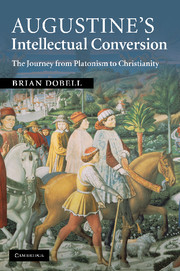Book contents
- Frontmatter
- Contents
- Preface
- Note on translations and references
- Chronological table of Augustine's writings
- List of abbreviations and texts
- Introduction: Augustine's conversion to Christianity
- PART I THE WAY OF AUTHORITY AND ‘THE FALSITY OF PHOTINUS’
- PART II THE WAY OF REASON AND THE ASCENT OF THE SOUL
- Conclusion: Augustine the Porphyrian
- Appendix: true and false in Soliloquies II
- Bibliography
- Index
Conclusion: Augustine the Porphyrian
Published online by Cambridge University Press: 01 June 2010
- Frontmatter
- Contents
- Preface
- Note on translations and references
- Chronological table of Augustine's writings
- List of abbreviations and texts
- Introduction: Augustine's conversion to Christianity
- PART I THE WAY OF AUTHORITY AND ‘THE FALSITY OF PHOTINUS’
- PART II THE WAY OF REASON AND THE ASCENT OF THE SOUL
- Conclusion: Augustine the Porphyrian
- Appendix: true and false in Soliloquies II
- Bibliography
- Index
Summary
In this book I have advanced a significant new interpretation of Confessions 7.9.13–7.21.27. I reject the standard interpretation of this narrative, according to which Augustine is describing events that transpired over the course of a few months in the summer of 386. I also reject O'Connell's view, according to which Augustine is not intending to provide an historical account of his intellectual development in this narrative. My view is that Augustine does mean to recount historical events – moreover, I believe that his recounting is considerably more precise than is generally appreciated – but that the period of time in question extends over roughly ten years (386–c. 395). I have supported this contention with two independent, yet complementary, arguments. First, I have argued that the Photinian Christology described at Confessions 7.19.25 is to be identified with the Christology of Augustine's early writings (386–c. 391), and that Augustine did not reject this Christology until c. 395. Second, I have argued that Augustine's ‘Platonic ascents’ (Confessions 7.10.16 and 7.17.23) describe the method of ascent that Augustine was developing from 386 to 391, and that Augustine did not reject this method of ascent until c. 395. I believe that this interpretation makes the best sense not only of Augustine's early writings, but also of the narrative in the Confessions itself. On the standard reading of this narrative, there are a number of obvious anachronisms that must somehow be accounted for.
- Type
- Chapter
- Information
- Augustine's Intellectual ConversionThe Journey from Platonism to Christianity, pp. 228 - 236Publisher: Cambridge University PressPrint publication year: 2009

